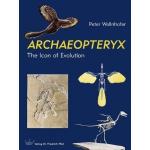Peter Wellnhofer  holds the distinction
of having been the pre-eminent
world authority on both
Archaeopteryx
and the pterosaurs
for over 30 years, a distinction
enjoyed by few scholars on comparable
fossil organisms. This semi-popular,
lavishly illustrated, and copiously
documented book is the crowning
achievement of his work on
Archaeopteryx. It comes at an auspicious
time, given the Darwin celebrations
of 2009 and the role that
the world’s most famous fossil bird
has played in evolutionary theory.
holds the distinction
of having been the pre-eminent
world authority on both
Archaeopteryx
and the pterosaurs
for over 30 years, a distinction
enjoyed by few scholars on comparable
fossil organisms. This semi-popular,
lavishly illustrated, and copiously
documented book is the crowning
achievement of his work on
Archaeopteryx. It comes at an auspicious
time, given the Darwin celebrations
of 2009 and the role that
the world’s most famous fossil bird
has played in evolutionary theory.
For the readers of NCSE, it should first be said that the “controversy” that Archaeopteryx has traditionally played in the creationist literature (including the more recent instars of the “intelligent design” movement) is not his subject. Wellnhofer feels that NCSE takes care of that very well, which is a real compliment to our organization. This frees him to explore the science of Archaeopteryx. Wellnhofer’s approach is fundamentally historical: the background of the story, each specimen, each paleobiological problem, is treated historically and comprehensively. Wellnhofer is in a very good position to do this, because he has surveyed the historical literature in the field for 40 years. His survey reminds us that few ideas are really new, and that even though the internet can bring us scads of recent articles on any subject, this is no excuse for lack of scholarship in ferreting out and reading the older literature. Of course, some of this literature is obscure, not widely accessible, so it is good to have it brought to our attention.
Wellnhofer begins with the town and region of Solnhofen, Bavaria, whence all ten of the skeletal specimens as well as the original feather have come. He situates Solnhofen in its historical, cultural, geographical, and geological context, presenting information that will be unfamiliar to most American readers. The famous Solnhofen limestones, which have been quarried for millennia, represent the bottom of an ancient, relatively quiescent, anoxic lagoon where critters in various stages of decomposition settled and were buried. Occasionally they died in their tracks there, like the fossil crabs that wandered in and found the poisonous environment not to their liking. This also prevented a lot of scavenging and other post mortem biotic destruction of the specimens, and thereby improved fossilization potential.
The bulk of the book concentrates on descriptions, historical accounts, and illustrations of the Archaeopteryx specimens themselves. It is wonderful to have these clear, straightforward descriptions in one place, laid out in simple language with both color photos and concise illustrations. All of these characteristics have been hallmarks of Wellnhofer’s work throughout his career, and they should be emulated by all paleontologists. He also provides a comparative table of measurements, all the more reliable for being taken by a single expert researcher.
The final part of the book concerns various issues that have historically involved the Archaeopteryx specimens. How many species are really present? (One) What is the correct nomenclature? (Archaeopteryx lithographica) ... and so on. These questions seem to have easy answers, but they are historically complex. Other questions are less easy to answer. Wellnhofer bends over backward to be open-minded, although some of the more recent literature has rather settled many of these. He is also not much of a cladist, so he does not situate Archaeopteryx into nested sets of shared derived characteristics that demonstrate its phylogenetic position (perhaps to the relief of many readers). On the other hand, his literature review is admirably complete, with the exception of some of the most recent works.
One of the most poignant aspects of the book is Wellnhofer’s description of how the friable, easily separated layers of Solnhofen limestones (the Fäulen) are cleared away as rubble, because they can’t serve as building or lithographic stone (the Flinze). How many irreplaceable fossils, he wonders, are destroyed by this process? And this is echoed in his afterword, which laments that in Bavaria there is no law to protect the destruction or private sale of such specimens, a problem that has touched several of the ten current skeletal specimens of Archaeopteryx.
Obviously, paleontologists, ornithologists, and fossil fanciers will want this book, but it should also be on the shelves of public and school libraries, because it lays out in clear and unbiased detail the facts that surround the world’s most famous fossil and a true icon of evolution. No one is likely to replace this book’s scholarship or its production quality for a very long time, so it should be bought and cherished for the future.
